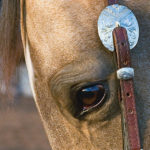Rainy days present the perfect opportunity to clean your saddle. You?ll need saddle soap, neatsfoot oil, several rags and sponges, and lots of elbow grease. Because it’s a messy chore, it’s best to put down a sheet of plastic and get to work in the garage or barn aisle.

Here Are a Few Tips:
??? ?Remove all saddle parts: latigo, cinch, back cinch, stirrups, conchos and other silver pieces.
??? ?Scrub the entire saddle ? all but the sheepskin on the flipside ? under the fenders and in all the nooks and crannies with saddle soap.
??? ?Remove stains from leather with cleaning fluids (or cleaning fluid mixed with cornstarch for stubborn stains).
Get into the routine of saddling your horse correctly by downloading AQHA?s FREE Saddling a Horse report. Or, keep scrolling down to see a video from a great AQHA alliance partner, the Certified Horsemanship Association.
??? ?Rinse
??? ?Use neatsfoot oil to condition the leather. Do not over-oil the saddle because this will soften it too much.
??? ?When the oil is dry, buff the leather with a soft cloth.
??? ?Use sandpaper to raise the nap of roughouts.
??? ?Straighten out the kinks in saddle strings by pulling them through a leather conditioner-treated cloth held between your thumb and forefinger.
??? ?Use a circular motion to brush suede or roughout seats with a wire, bristle or rubber brush.
More Tips
??? ?Use toothpaste and a toothbrush to clean grime off bits.
??? ?Hang your bridles from old saddle soap tins nailed to the tack room wall to help them keep their rounded shape.
??? ?When trimming your horse’s ears, place cotton inside them to reduce clipper noise.
??? ?Use the dish-washing tool with the sponge at the end of a hollow tube to clean tack. Fill it with liquid saddle soap instead of dish soap.
??? ?Use a chamois to rub down your horse after a bath.
All of your saddling questions are answered in AQHA?s Saddling a Horse report.
The Certified Horsemanship Association has provided you with a chance to learn how to saddle your horse correctly. The purpose of CHA is to promote safety and education for the benefit of the horse industry.





